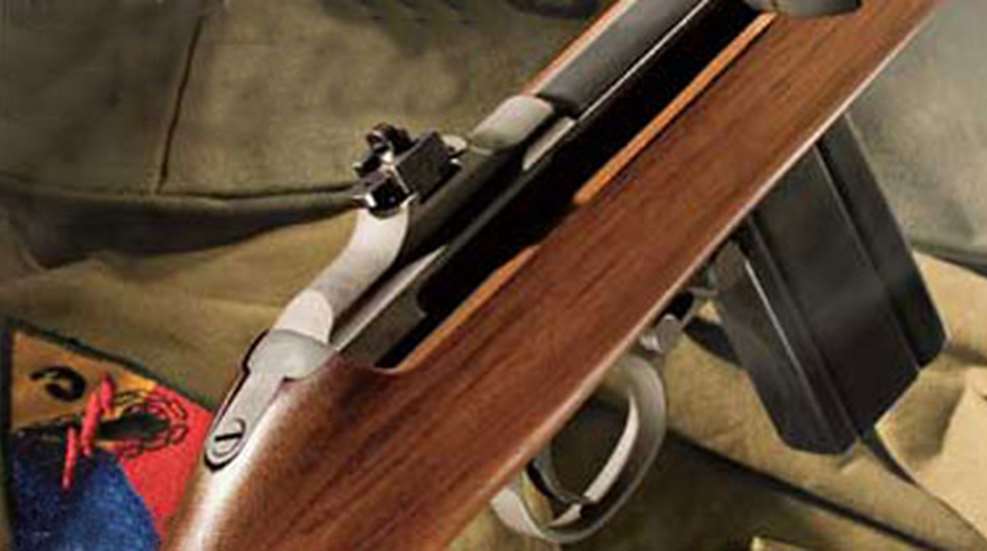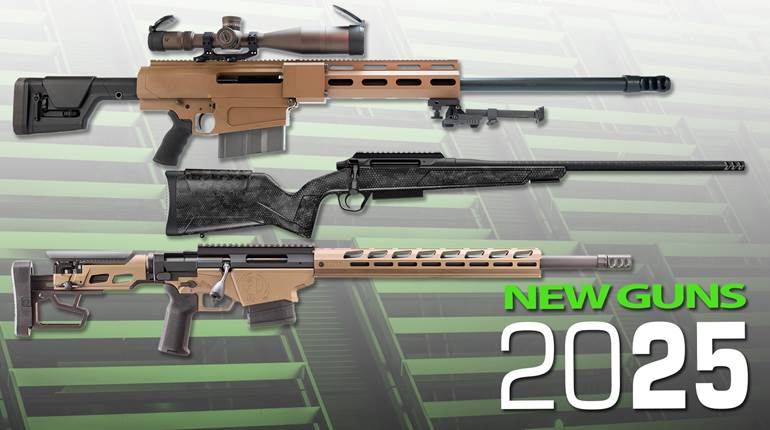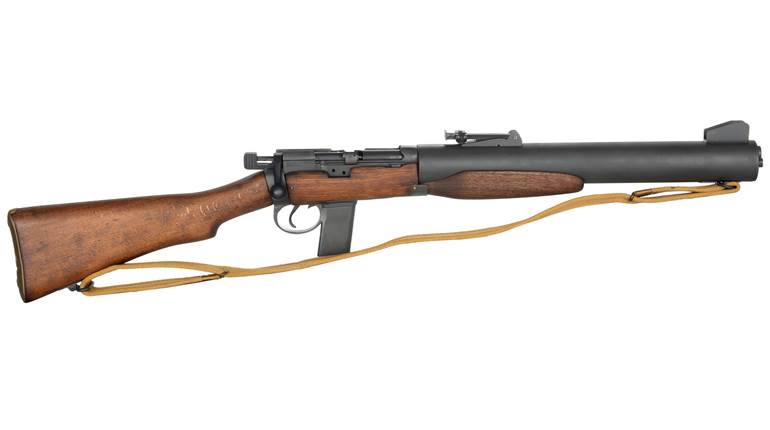
More than 6 million M1 Carbines were made between August 1941 and June 1945 (6,221,220 to be exact). Intended to be a better personal arm than the M1911A1 .45 ACP pistol for support troops and those encumbered by heavy weapons, the “U.S. Carbine Cal. .30, M1” ended up being the U.S. military’s most-produced arm ever. But try buying one now.
Sure, you can find them, but all-original guns go for as much as $3,500 (for a nice folding-stock M1A1), and even U.S. government rebuilds of fixed-stock guns can go for $800 and up. A host of carbines were provided to America’s allies under various military assistance programs, but most have not returned due to import restrictions. They also cannot be sold to individuals though the Civilian Marksmanship Program.
At a couple of recent gun shows, the best deal I was able to find was a very, very beat-up Inland import with a bore that looked like it had only traces of rifling and an oily, Korean-made stock that was turning to mush. The price: $575, firm. These days, if you want a nice shooter, you end up competing with the ever-growing carbine collecting fraternity. And collectors risk devaluing pristine examples through a lot of shooting.
That’s why, at the SHOT Show two years ago, I was literally stopped in my tracks by the sight of an M1 Carbine resting on the lowest peg of a rack in the Kahr Arms/Auto-Ordnance booth. It had the late parts and ventilated-metal handguard of the IAI M1 Carbine we reviewed in these pages in January 2001.
“You don’t make these,” I said to Frank Harris, the firm’s vice president of sales and marketing, as I turned the gun over and over in my hands.
“We do now,” he replied.
“Plenty of guys will buy and enjoy this gun,” I said, pointing out the late parts and ventilated-metal top handguard. “And good for them. But what you ought to make is a gun that looks just like a World War II gun, a D-Day gun.” I went through the gun part-by-part—flat bolt, flip sight, push-button safety, barrel band sans bayonet lug, etc., etc.—first with Frank, then Sam Wada, vice president of client operations, and finally company owner Justin Moon. “If you have to make new parts anyway, you might as well make parts that guys want,” I advised them.
I arranged for my friend Phil Schreier from NRA’s National Firearms Museum to send his personal, pristine March 1943 Saginaw-made M1 Carbine for Sam and his colleagues to study. (I’ve asked Phil to leave the Saginaw to me in his will in the event anything unfortunate ever happens to him.) Last year at the SHOT Show, Sam took me through the gun part-by-part and let me know the progress of the project. In November 2005, the result of their efforts arrived in a brown cardboard box emblazoned with “Made With Pride In the U.S.A.”
Kahr had been machining receivers for IAI, but after some business difficulties with IAI, Kahr decided to go into carbine production under its Auto-Ordnance name, which fits, as Auto-Ordnance produced receivers and some other parts for International Business Machines during World War II. These original guns were marked “ao” below the serial number. The new guns have the two-line “u.s. carbine cal 30 m1” on top of the receiver’s front and a lightly engraved “auto-ordnance worcester, ma” at its top rear. The serial number is on the receiver’s left, not on the top like the original guns.
Just to brief those who don’t know a lot about it, the M1 Carbine is a gas-operated, .30-cal., semi-automatic rifle that uses a short-stroke piston system and a reciprocating operating handle. Overall length was 35.5 -inches, and the gun weighed about 5.5 pounds, unloaded. Muzzle velocity with a 110-gr., jacketed round-nose bullet was around 1900 f.p.s. It was originally fed by 15-round detachable box magazines—30 rounders weren’t adopted until 1945. The operating handle is on the right, and its bolt could be locked in the open position by retracting it, lining up its locking pin with a recess for it on the receiver’s top right, and pressing it down. The Auto-Ordnance conforms to the original design in just about every way.
Unlike the IAI gun reviewed previously, all the sample gun’s significant parts are newly manufactured. The receiver starts as a 4140 steel investment casting that is then finished on the firm’s CNC machines. The operating slide is also an investment casting finished by CNC machines. This part, too, was made originally by Auto-Ordnance for IBM.
The trigger guard assembly is also a machined casting. In fact, the precision work on the new gun actually outshines most original guns I have examined. The two-lugged bolt, with its extractor in the right lug, is the early flat type. The barrel is made by Green Mountain Barrels for Auto- Ordnance and has four-groove rifling with a 1:20-inch, right-hand twist. The post front sight and protective ears are retained by a crosspin.
The magazine release, on the front right of the trigger guard assembly, is of the elongated push-button type, lacking the “M” of later carbines. Pressing it from right to left allows the magazine to drop free. The barrel band has the front sling swivel and vertical retaining screw on the left side, again, a feature found on early carbines, as no bayonet was issued with the little gun until 1945.
The rear sight is the early non-adjustable flip type, with two heights, one for 100 yards and one for 300 yards. Its base is dovetailed into the receiver and is drift-adjustable for windage. On our sample carbine, it was pretty stiff at first, but eventually broke-in with use. It and its base, unlike the rest of the metal parts, are blued, not Parkerized.
The sample’s well-finished, two-piece stock is of American walnut with attractive grain. The fore-end is of the somewhat later low-wood type that leaves the operating slide uncovered (the high-wood fore-ends broke a lot). There is a recess for the oiler and sling attachment in the side of the buttstock. It is of the “oval” type, not the very early “I-cut” variety. There is also a birch-stocked model offered, but thankfully the metal handguards have been dropped entirely.
The only change I’d like to see are “ao” markings added on some of the parts, such as the rear sight, bolt and safety, so collectors in the future will not mistake Auto-Ordnance’s modern-made parts for original ones. As a matter of fact, Auto-Ordnance is seriously thinking about offering many of its modern remakes of early parts to consumers.
So with the M1 Carbine, Auto-Ordnance is in the nostalgic gun business. The Tommy gun—in semi-automatic of course—the M1911A1 pistol and now the M1 Carbine, are all offered by the company founded by Gen. John T. Thompson back in 1919. All-in-all, this is the best commercial M1 Carbine that we have ever received. It looks close to the guns that went ashore on D-Day and Okinawa. They’re brand new, have a warranty from Auto-Ordnance, and the one we had shot like a champ, averaging groups right at 2 inches at 100 yardds., even with rudimentary iron sights. Out of more than 500 rounds fired, there were no malfunctions of any kind with G.I. magazines. Magtech’s affordable 110-gr. FMJ loading in particular impressed us at the range.
It seems that a generation has missed out on some of the M1 Carbine’s positive attributes. “Boy, are they all this light?” remarked one staffer who picked the little gun up from my desk and shouldered it. Many shooters simply have never really spent any time with a carbine. At the range, too, the new rendition of the gun favored by so many G.I.s (stopping power aside) won some hearts and minds of our younger staffers.
At $705 for the walnut-stocked version and $674 for the birch-stocked gun, Auto-Ordnance’s carbine makes a fine alternative to an original for those interested in owning and shooting these fun and historically significant little guns. Best of all, an M1A1 “paratrooper” carbine is in the works. Former American Rifleman staffer Ted Hatfield sent his original M1A1 to the company as a pattern. Auto-Ordnance has produced a sample M1A1, but has advised it will cost around $800. If you would like one, let Auto-Ordnance know, because your input will determine whether or not a new M1A1 will “Stand in the Door” yet again.
Manufacturer: Auto-Ordnance Corp.; (508) 795-3919
Caliber: .30 Carbine
Action Type: gas-operated, semi- automatic, center-fire rifle
Receiver: investment-cast 4140 steel
Finish: Parkerized
Barrel: 17 3/4"
Rifling: four-groove, 1:20" RH twist
Magazine: detachable box, 10-, 15- (tested) or 30-round capacities
Sights: protected blade front; two-position peep rear, drift adjustable for windage
Trigger Pull: two-stage, non- adjustable, 4 lbs., 2 ozs.
Stock: American walnut: length of pull, 13 1/2"; drop at heel, 2"; drop at comb, 1 7/8"
Overall Length: 35 5⁄8"
Weight: 5 lbs., 7 ozs.
Accessories: manual, trigger lock, one 15-round magazine
Suggested Retail Price: $705 (walnut), $674 (birch)





































